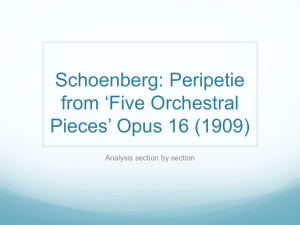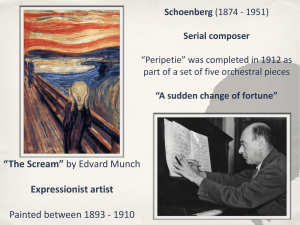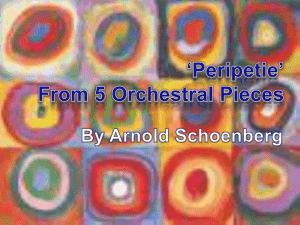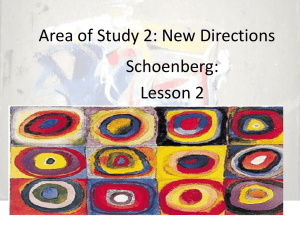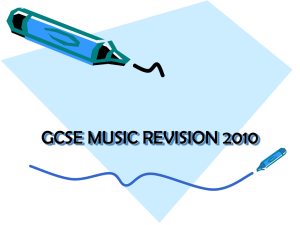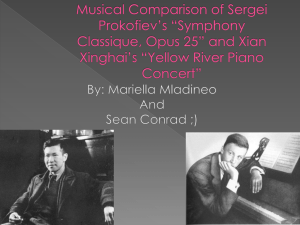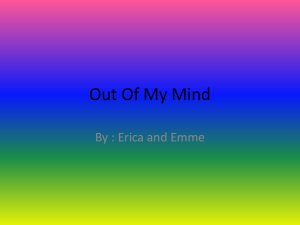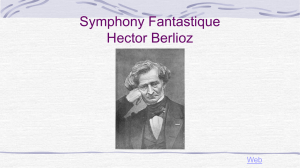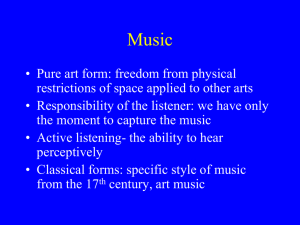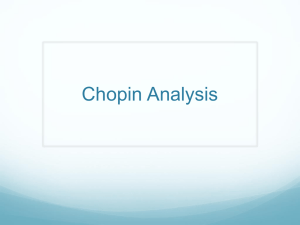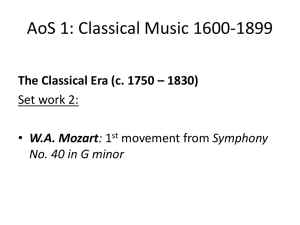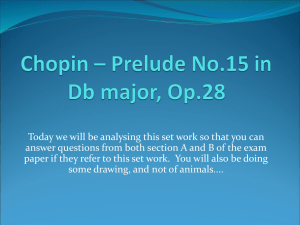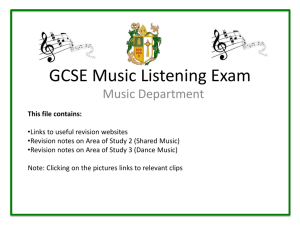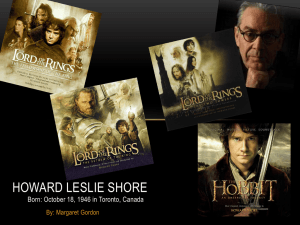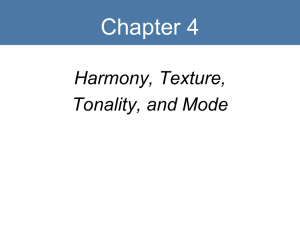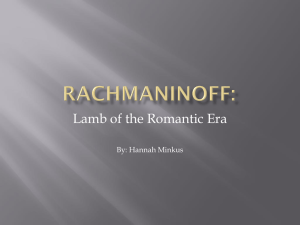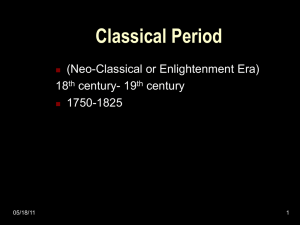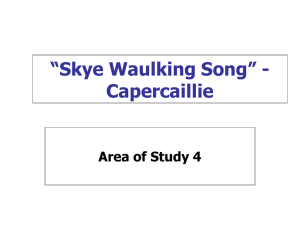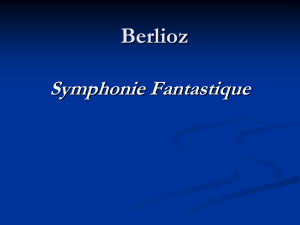Peripetie for 5 Orchestral Pieces, Op. 16 by Schoenberg (1909)
advertisement
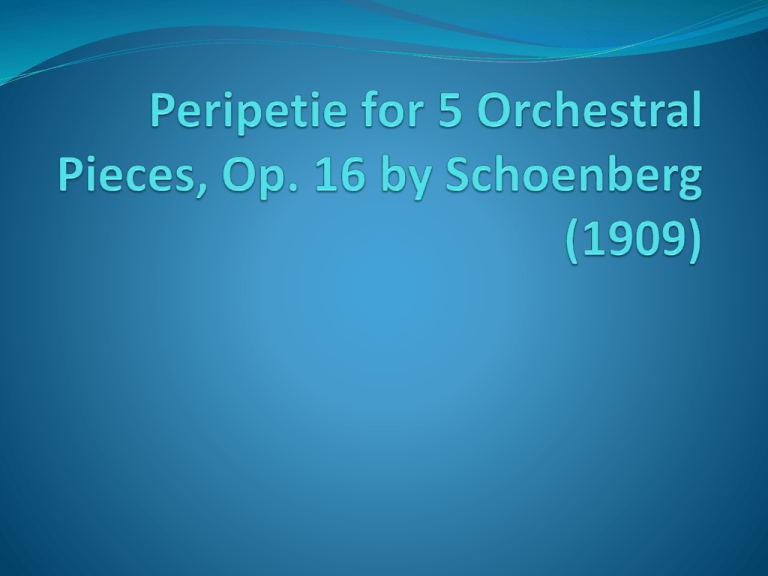
Before Expressionism Towards the end of the 18th Century, composers of the late romantic era were producing longer, grander pieces of music. Symphonies = Bruckner, Brahms, Mahler Opera = Verdi, Wagner Composers would put effort into ensuring that the structure was interesting through the use of different keys, harmonies, themes and textures. Before expressionism continued... Brahms = Wrote in strict forms (borrowed from the Classical and Baroque eras) but on the scale typical of Romantic music. Inspired by Beethoven. Wagner = Made extensive use of Chromaticism and frequent modulations, leaving the key of a piece often unclear. Builds up the tension with ‘endless melody’. ‘Endless Melody’ comes from the lack of cadence points, the opposite of Mozart and Haydn who use them regularly to punctuate their music Expressionism Early 20th Century composers reacted to the works of late 18th Century composers by either using classical forms and key relationships in their own way or abandoning them altogether. Impressionist Composers = Debussy and Ravel, wrote music with recognisable chords and harmonies, combining them in original ways and using instrumental ‘colour’ to paint musical pictures i,e. Use of chords out of their normal context (parallel dominant 7th chords as opposed to using one before resolving to the tonic). Expressionism Schoenberg = Thought ‘tone colours’ as important as melody, inventing the term ‘Klangfarbenmelodie’, or ‘tone colour melody’. This describes how instrumental timbre contributes to the melody and the pitches themselves. Schoenberg took Wagner’s use of chromaticism to its logical extreme – abandoning tonality and key relationships, writing entirely atonal music. Features of Expressionism Atonal – Gives each semitone equal importance Each piece expresses one, intense emotion. Use the full ranges of instruments, exploring the pitches available at the extremes. Timbre is as important as melody Extreme dynamics – Very dramatic when played in a large ensemble. Quite short pieces – It is difficult to write extended pieces in this style, without key relationships and recognisable themes in the traditional sense to form a structural framework. Arnold Schoenberg (1874 – 1951) Born in Vienna Started the violin age 8. Started composition as a child in a self taught fashion, just experimenting. Started composition lessons in his ‘teens. Started writing professionally at the end of the 18th century, writing in the late romantic style and using the large orchestra associated with the era. Taught composition in Berlin (Berg and Webern were 2 of his pupils) Was Jewish, though adopted Protestantism for a number of years. Moved to Paris in 1933 and then onto California after his music was labelled ‘decadent’ by the Nazis. Moved to atonal music after a traumatic period – Wife left him and for a friend and then committed suicide, he was also in financial difficulty. Lots of intense emotion to express!! Background to Five Orchestral Pieces Set of Atonal pieces for full orchestra Uses pitches and harmonies for effect, rather than their relationships to each other. Concerned with timbre. Was approached by Richard Strauss in 1908 to send him some short pieces for Orchestra, with the idea of showing them to important musical figures of the time. These were sadly not well received. Schoenberg liked to conceal things within his compositions, believing that intelligent and attentive listeners would see deeper meaning in the music. Titles were not added to each of the pieces until 13 years after they were composed. Schoenberg was advised that they would help the audience to respond better to his music. The Hexachord Hexachord – The main ‘code’ in Schoenberg’s pre- serialist music. Made up of six notes played as a chord. Hear first in the horns as C, Bb, E, F, C#, A. Rearranged in ascending order – A, Bb, C, C#, E, F. Used as a chord and as a melodic motif, with the notes arranged in any order. The melodic motif can be transposed and the notes played in any octave. The hexachord is used in both forms throughout the piece. The Compliment and score markings. Made up using the other 6 semitones available In this case = B, D, Eb, F#, G, G~. This can be transposed and reordered like the hexachord. In the 1952 revised score, symbols were added to show who had the primary voice and who had the secondary voice. = Haupstimme, or principal voice = Nebenstimme, or secondary voice = Is used to close brackets, when the main melody is no longer being played by the instrument. Structure In 5 sections Broadly in Rondo form, though the returning A sections are hardly recognisable. The A section shows a return to particular mood or orchestral sound rather than to a theme. Section A Overview: Bars 1 - 18 Begins very loud! Clarinets and flutes state 2 hexachords – Bar 1 = C#-D-E-F G#-A in the clarinets and A-A#-B-C-E-G# in the flutes Builds up to ff fanfare-like horn motif marked Bassoon plays the clarinet hexachords from bar 1, the same as the horn motif from bar 8 but transposed up 4 semitones. Lots of hexachords are used throughout the piece. You are not expected to analyse all of these chords but you must be aware that they are used melodically and harmonically throughout and it is worth knowing a few examples. Section A Overview: Bars 1 – 18 Tempo and rhythm Marked Sehr Rasch – Very quick. Crotchet = 100-108bpm Mainly made up of short triplet and sextuplet bursts. After the demisemiquaver hexachord burst, the tempo becomes slightly slower through the quiet horn passage. This leads to an expressive rubato clarinet line from bar 10. Section A Overview: Bars 1 – 18 Instrumentation and texture Tutti orchestra is used for the opening before they get to rest for a while. Brass dominates the texture until bar 8, where the woodwind takes over (low bassoons, bass clarinet ostinato and clarinet melody) Instruments drop in and out in quick succession with dovetailing, homophonic bursts. Loud hexachord texture thins out to solo clarinet line. Section A Overview: Bars 1 – 18 Pitch and Melody No sense of key – atonal and build on hexachords Hear the full pitch range of all the instruments Clarinet melody is expressive and gentle Angular and dissonant, with leaps of a minor 9th and major 7th – intervals usually used to accentuate dissonance and create tension. Section A Overview: Bars 1 – 18 Dynamics Begins loudly Crescendos to fff until dying away after bar5 to pp. Trumpets and trombones play muted. Mutes are used for sound quality, rather than to effect the dynamics, for which the mute was not originally designed. See next slide for a full score to see all the examples. Section B Overview: Bars 18-34 Tempo, Rhythm and Dynamics Tempo returns to original marking. Short note durations give the illusion that the tempo has increased more than it has. Section begins quietly with an immediate crescendo Dynamics vary between instruments Haupstimme and Nebenstimme are always marked as f-fff. Dramatic and frequent dynamic changes Section B Overview: Bars 18-34 Instrumentation and texture Full orchestra, but not all at once, except for climatic points i.e. Bars 30-34 Even here, strings leave to woodwind and percussion to provide much of the power. Soft line written for violins and cello, which is almost inaudible but adds to the texture and timbre. Texture = Very polyphonic and complex Section B Overview: Bars 18-34 Pitch and melody Haupstimme snakes through most of the orchestra In 24-28 it bounces from one brass instrument to the next, demonstrating the klangfarbenmelodie idea. The Nebenstimme appears in this section, for its only appearance in the whole piece. Bar28(2) to Bar 31(1) = Trumpet 1 Bar29 = flutes, piccolo and clarinet Section A’: Bars 35-43 Marked by the string section rising from nothing Followed by a flourish in the horns then a return to the hexachord from bar 8. Several instruments briefly disturb the horn chord Section is a brief rest from the turmoil of section B A menacing mood, rather than tranquill, giving the impression of more fireworks to come. Section C Overview: Bars 44-58 Bassoon take over the Haupstimme but immediately pass it on to the solo cello. Bassoon - Cello Tempo = alternates between Ruhiger (calmer) and Heftig (passionate) Texture is much more sparse, focus is on overlapping instruments – Delicate us of the orchestra until the fff in bar53 Dynamics range from pp (bar 44/45) to fff (bar 53-55), with individual instruments rising above others with individual crescendos. Section A’’ Overview: Bars 59-66 Tempo, rhythm, instrumentation and texture Rhythmic motifs from the open bars return here i.e. Trumpet in bars 61-63 Starting with clarinet and strings, instruments are introduced in quick succession (layering the rhythmic motif) Full orchestra used for climatic chord at bar 64 Section A’’ Overview: Bars 59-66 Pitch, Melody and Dynamics. Material from the opening used and developed in this section. No voice is marked more important than the others Bar 64 chord (see previous slide) is a giant hexachord in all of the orchestra except Cor Anglais and Double Basses. Basses play an unrelated tremolo chord (very high). This sustains after the rest of the orchestra has finished to conclude the piece. Bar 50 = pp to Bar 64 = ff, immediately dying away to nothing but tremolo basses and pp horns. Key words Cor Anglais Opera Polyphonic Klangfarbenmelodie Hexachord Sehr Rasch Endless Melody Tutti Nebenstimme Ostinato Heftig Haupstimme Homophonic Transposed Symphony Rondo Dissonance Ruhiger Monophonic Chromatic Muted Atonal Timbre Rubato
